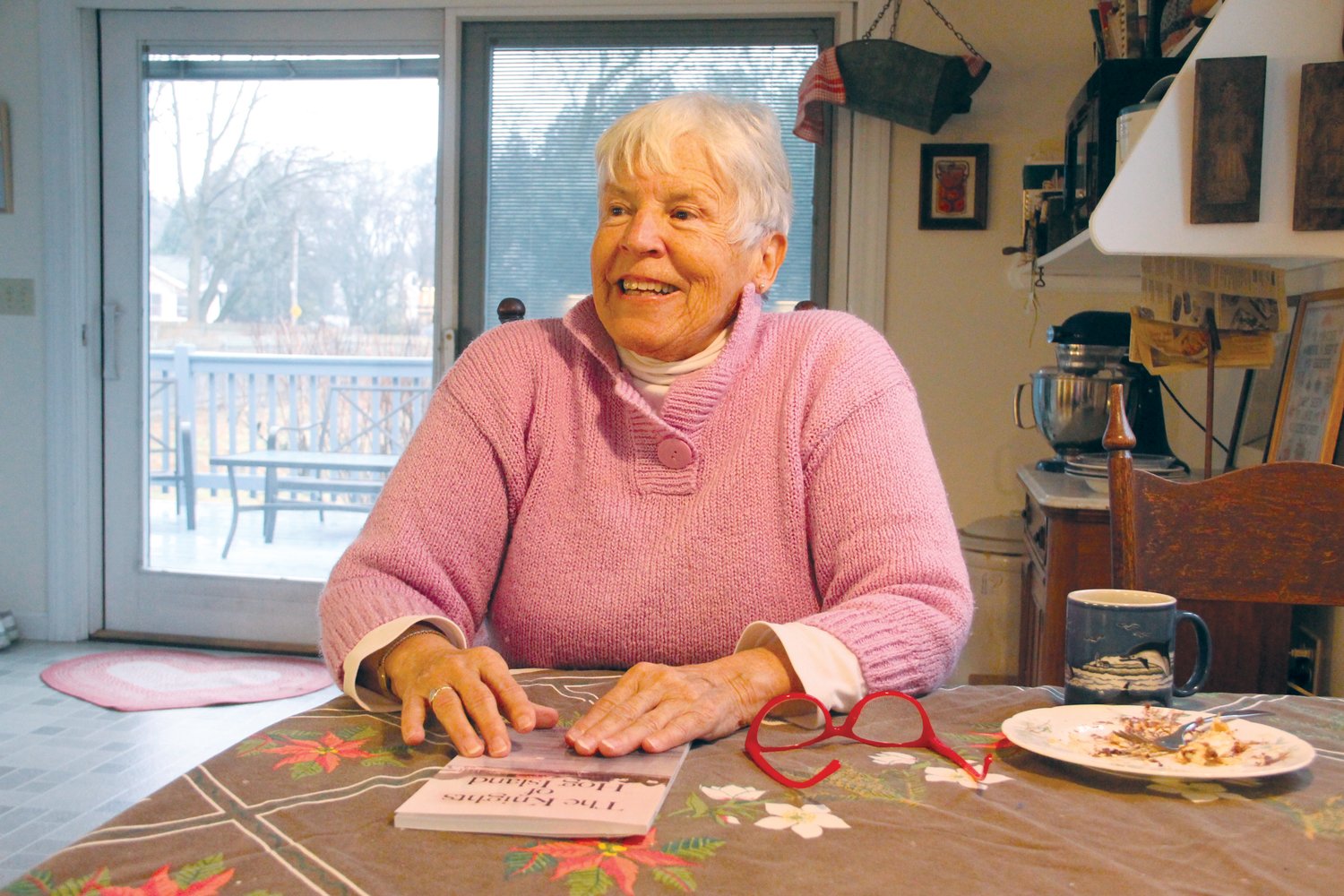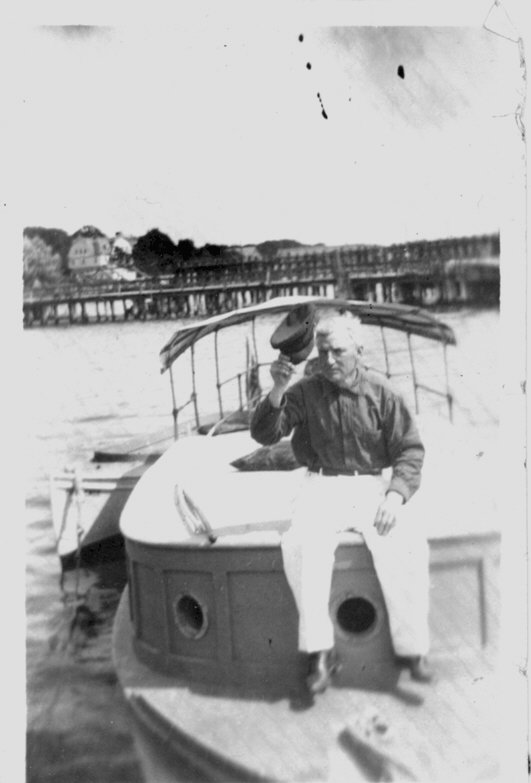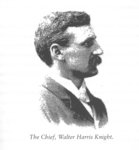Island times retold
Remote, yet close by, Hog Island book is a treasure of family stories
Whatever inspired someone to name 200 acres overlooking Bristol harbor to the north, Mount Hope Bay to the east, Newport and the East Passage to the south and Prudence Island to the west - spectacular views in every direction - Hog Island? Folklore is that the colonialists hid their livestock and a lot of pigs on the island during the Revolution and the name stuck.
Joyce Fairchild Almeida who has spent many summers on the island will tell you otherwise. She should know. Almeida has written a book about the island, not about how it got its name, although that is in the book, but her great grandfather Walter Harris Knight who bought the island in 1901, his descendants and the extended Knight family that shouldn’t be confused with the Knights who owned the Pontiac Mills, home of Fruit of the Loom and for whom the CCRI Knight Campus is named.
The book is filled with stories of island summers, her relatives, the escapades of visitors and the joys and tribulations of being on an island.
But first, even before Almeida handed over a copy of the book at a recent interview where she served chocolate cream pie, she had a book story. She wrote and published about 500 copies of The Knights of Hog Island 30 years ago. Friends and relatives bought copies and Almeida gave away quite a few. Years went by and Almeida started getting inquiries as to where to find her book. That kindled her interest and as it turned out reignited her passion to tell stories.
Indeed, Almeida found a copy of her book in a form different than what was published. A man had photocopied the book and put the pages in a 3-ring binder. The binders were selling for three times what Almeida had priced her work. Almeida learned there was little she could do. She had not copyrighted the book. After all the research she put into the book, that galled her. It also inspired her to publish the book again along with updates to the story and, naturally, copyrighted. Dorrance Publishing Company of Pittsburgh, Pennsylvania published the book in the fall of 2021.
The Chief of the Knights
Known as the Chief, Walter Harris Knight was an inventor whose work took him to many parts of the world. A company he founded, Bentley-Knight, was a forerunner to General Electric where Knight, who designed the electric trolley car, later became chief engineer of the railway division.
Knight’s inventions made him a good deal of money that evidently went as quickly as it came. His family understood that and had ownership of the island placed in a family trust otherwise it, too, might have gone.
So how did Knight come to buy an island with such a name?
“The Chief was experiencing one of his wealthy periods,” Almeida writes in the opening lines of the book. He was sitting on the porch of the Bristol Golf Club, across from the island with Dr. Herbert Howe, a Philadelphia physician and descendant of the DeWolf family of Bristol. Knight complained all the beach rights around Narragansett were being bought up.
“If you want beach rights, buy my island over there. It will give you all the beach rights you need,” Howe is quoted as telling Knight. That was it. Knight bought the island that had an old farm on it. It didn’t stay that way for too long. Soon after his acquisition, the Chief attended the Pan American Exposition in Buffalo where he found a deal. At the conclusion of the exposition when the transportation exhibit was being dismantled he bought the windows, roof tiles and doors of the building and had them shipped via the Erie Canal to the Hudson River and then up the east coast to Hog Island.
It was the beginning of an island enclave of Knight relatives. “The Big House,” and its red tile roof that can be clearly seen from the Mt. Hope Bridge is now one of about 30 Knight-related homes on the island.
Much of the book is about the Chief and, of course, island exploits from building a tower with a high beam searchlight to catch poachers of the oyster beds designed as one of several moneymaking ventures to planting of dynamite to destroy the hull of a vessel that sank at the boathouse dock and impeded swimming.
“The explosion sent timber shooting up over their heads, above the roof of the boathouse, and over the dock. Pieces were raining down half a mile out on the bay when it dawned on them they must have used too much dynamite.”
Lost last fortune
Almeida also tells how the Chief lost his “last fortune” with an investment in an ammunitions company two weeks before the end of World War I. The chief became president of the company that quickly had no market to sell its products. Moreover, as the Chief was to learn, the company was the subject of a FBI investigation, yet another twist in the Hog Island story.
The Knight offspring were no less daring. Almeida writes of the construction of the Mt. Hope Bridge in 1929 and how cousins who walked on the roof of the Big House and climbed the flagpole saw the bridge as a challenge. They climbed the bridge to its highest point, walked the cables and removed light bulbs as proof of their daring exploits.
Almeida writes of Saturday night clambakes where the island clan would gather at the boathouse and cook “ring tum ditty,” a Girl Scout recipe of tomato, bacon, melted cheese and corn cooked over a campfire and served on fork-roasted bread. Almeida describes the expanse of inland sky, the starry nights and the languid summer days. Then, too, there are the challenges of commuting to the mainland - there’s no longer a ferry to Hog Island - no water system, no trash pickups, no school, no police to patrol, no fire department.
The island is part of Portsmouth, but Hog Islanders don’t have a vote at Portsmouth Town Meetings even though they pay Portsmouth taxes (they get a break as the land is appraised as farm land).
They have been faced with vandals and unwelcome bird hunters (one of them turned out to be the Portsmouth chief of police) and even squatters that claimed rights to a shack they built near the island dump. They went to court over that.
As a girl, Hog Island became Almeida’s summer home. The Fairchild family lived in Venezuela where her father was chief engineer for the Uniroyal tire plant. It was on Hog Island where she met her future husband - they waited until their 21st birthday to marry - the late Ray Almeida.
Ray went on to become a physical education teacher, football, track and cross-country coach at Veterans Memorial High School in Warwick.
Joyce was active in the Junior Women’s Club and as its president was instrumental in the founding of the Warwick Museum that opened in 1976 at the Pontiac Mill and later moved to the Kentish Armory in Apponaug where it is now the Warwick Center for the Arts.
Now retired, Joyce became a Warwick teacher assistant, a job she loved especially working with Donna Walsh at Greene Elementary School and it gave her the summers off to be on Hog Island.
Today, Joyce and the Almeida’s children, Becky and Doug, as always, look forward to their island time.
And the name: Hog Island?
Joyce digs into that in the opening pages of her book. The island went by a number of different names and there was even a time when it was called Perry Island for the grandson of Captain James DeWolf, James DeWolf Perry, but it didn’t stick.
Joyce’s summation is that the name goes back to colonial times when swine were kept on the island, but it probably had nothing to do with hiding livestock from the British during the Revolution.
The Knights of Hog Island sells for $12 and can be bought at the Warwick Beacon, 1944 Warwick Ave., Warwick, Tales Twice Told on Broad Street in Pawtuxet and on Amazon.
















